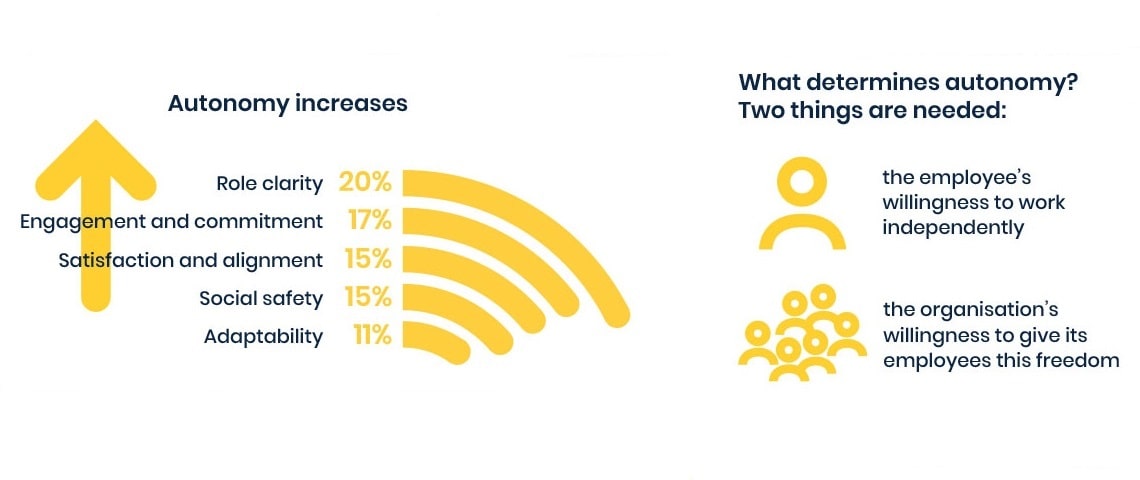"Beyond Hierarchy: Revealing Potential Power of Employee Autonomy in Modern Organisations"
The idea of autonomy has become essential to the success of organisations in the quickly changing modern workplace. Giving workers the freedom to decide for themselves, accept responsibility for their work, and cooperate in self-governing groups has emerged as a critical business strategy for companies looking to promote creativity, adaptability, and worker happiness. This essay examines the value of autonomy and examines the workings of self-governing teams, highlighting both their advantages and disadvantages.
The Essence of Autonomy in the workplace
Fundamentally, autonomy is the capacity for independent thought and decision-making. Giving workers the freedom to choose how they approach and complete their work is what this means in the context of the workplace. A staff that feels empowered is more likely to be engaged, creative, and productive, which is why old hierarchical structures are giving way to more decentralised ones.
(Rebecca Johannsen and Zak, 2020) describe how employees in certain firms value autonomy, purpose, and meaning in their job more than monetary pay. The above is further supported by (Rebecca Johannsen and Zak, 2020), who observe that because these job attributes are so significant, workers are happily taking up lower-paying positions that nonetheless have purpose and autonomy.
Furthermore, companies with cultures that intentionally or unintentionally support workers' pursuit of autonomy and fulfilling work experience reduced employee turnover and increased productivity. According to (Rebecca Johannsen and Zak, 2020), workers who are given the freedom to carry out projects are more effective and satisfied with their jobs.
Positive Association Between Autonomy and Job Design According to Edge (n.d.), autonomy is a crucial component of job design in which workers control the ideas and choices they make. There are three different kinds of autonomy: managerial, team, and employee. Employee autonomy is a crucial type of autonomy since it enhances workplace productivity and fosters stronger working relationships with a higher level of trust between management and staff.
Subsequently, Edge (n.d.) highlights the significance of understanding each employee's degree of discretion in making critical decisions during the job design process, as autonomy and responsibility are essential components of job design that are interdependent. Furthermore, Edge (n.d.) reports that a greater degree of employee autonomy has a significant and beneficial impact on the personality qualities of conscientiousness and extroversion as they relate to job performance. Because this could lead to better judgements being made and an increase in job satisfaction, management should assess each role when establishing tasks and take into account the appropriate level of autonomy.
Challenges of Implementing Autonomy in the workplace
Although there are many benefits to autonomy, it's important to recognise and deal with the difficulties in putting it into practice:
- Risk of Misalignment: Independent work groups may stray from company objectives in the absence of appropriate direction and communication. Efficient leadership and communication are necessary to keep individual and group goals in line.
- Possibility of Inconsistency: If there are no defined guidelines or standardised procedures, autonomous decision-making may result in inconsistent decisions made by teams. Achieving equilibrium between autonomy and organisation is essential to prevent disintegration.
- Communication Challenges: In self-governing work groups, efficient communication is even more important. It is crucial to make sure that information is shared among team members without any obstacles in order to avoid miscommunication, repetition of work, or the exclusion of some people.
- Need for Skill Development: In order for workers to succeed in a self-sufficient setting, they might need more training and development. When there is no continuous monitoring, abilities like problem-solving, decision-making, and productive teamwork become increasingly important.
- Opposition to Change: Workers used to a more hierarchical environment may be resistant to the shift from a traditional to an independent work structure. To get past opposition and make the move go more smoothly, change management techniques are crucial.
The Dynamics of Autonomous Work Groups
Team composition: People with a range of perspectives, abilities, and knowledge tend to form autonomous work groups. The team's ability to think creatively and solve problems is greatly influenced by this diversity. Shared Leadership: Independent work teams frequently use shared leadership models in place of a single leader. Every team member uses their strengths to take on leadership roles and participate in decision-making. Constant Feedback: To encourage a culture of continuous improvement, autonomous work groups must have regular feedback loops. Team members who get constructive criticism are better able to improve their performance and approach.
Transparent Communication: The foundation of effective independent work groups is open and honest communication. To make sure that everyone is on the same page and working towards the same goals, teams need to exchange information, updates, and insights. Flexibility and Adaptability: These are two qualities that autonomous work groups find very beneficial. Members of the team must be open to change, be flexible when needed, and continuously review their plans in light of changing conditions.
Case Studies: Companies Embracing Autonomy
Zappos: The online retailer of apparel and shoes is well-known for its dedication to worker autonomy and empowerment. Zappos has a holacratic organisational structure that does away with conventional hierarchies and promotes self-management.
Conclusion
Autonomy and independent work groups are emerging as key components of successful organisations in an era of perpetual change and growing complexity. Increased employee inventiveness, adaptability, and engagement exceed the difficulties in establishing autonomy. Accepting autonomy as a strategic requirement and a crucial differentiate in luring and keeping great individuals is becoming increasingly important as businesses continue to navigate the changing nature of work. Organisations may maximise employee potential and set themselves up for long-term success in the fast-paced, cutthroat commercial world by encouraging a culture of autonomy.
Reference
B Hiriyappa (2010). Team Building And Group Dynamic. B Hiriyappa.
Davis, L.E. and Taylor, J.C. (1972). Design of Jobs: Selected Readings.
Ellingson, J.E. and Noe, R.A. (2017). Autonomous Learning in the
Workplace. Routledge.
Kelly, J.E. and Clegg, C.W. (2017a). Autonomy and Control at the
Workplace. Taylor & Francis.
Kelly, J.E. and Clegg, C.W. (2017b). Autonomy and Control at the
Workplace : Contexts for Job Redesign. Milton: Taylor and Francis.
Rabenu, E. (2021). Twenty-First Century Workplace Challenges.
Rowman & Littlefield.
Susman, G.I. (1976). Autonomy at Work. Greenwood.
Kokemuller, N., n.d. What Is an Autonomous Work
Group?. [Online]
Available at: https://smallbusiness.chron.com/autonomous-work-group-14402.html
[Accessed 16 November 2023].
Muchskills, 2023. Why autonomous teams are so
important in the workplace today. [Online]
Available at: https://www.muchskills.com/blog/why-autonomous-teams-are-so-important-in-the-workplace-today
Noori Kaabomeir, K. M. A. M. K., 2023. How supervisors can
support employees' needs and motivation? an experimental study based on
SDT. Current Psychology.
Rebecca Johannsen, P. J. Z., 2020. Autonomy Raises
Productivity: An Experiment Measuring Neurophysiology. Frontiers in
Psychology, Volume 11.
Sharon K. Parker, D. A. a. A. V. d. B., 2019. Why
Managers Design Jobs to Be More Boring Than They Need to Be. [Online]
Available at: https://hbr.org/2019/06/why-managers-design-jobs-to-be-more-boring-than-they-need-to-be
Wooll, M., 2021 . Autonomy at work is important:
Here are 9 ways to encourage it. [Online]
Available at: https://www.betterup.com/blog/autonomy-in-the-workplace?hs_amp=truehttps://core.ac.uk/download/pdf/19494501.pdf
[Accessed 16 November 2023].






Comments
Post a Comment